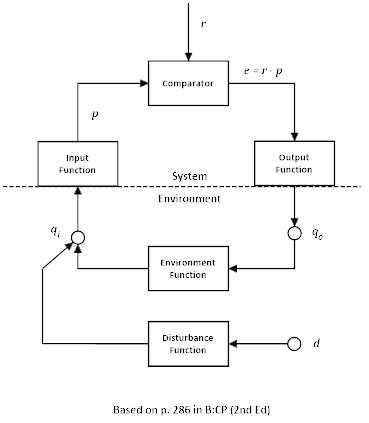[From Fred Nickols (2016.10.02.0826 ET)]
The diagram below is essentially the same one that appears on page 286 in B:CP (2nd Edition). The only changes I have made were to remove the annotations Bill used for linear analysis purposes. I have a few simple questions:

Is qo the controlled quantity?
Is p the perceptual signal that corresponds to qo?
In terms of my coffee cup example, is qo the amount of coffee in the cup?
In terms of my coffee cup example, is p my perception of the amount of coffee in the cup?
Regards,
Fred Nickols, Knowledge Worker
My Objective is to Help You Achieve Yours
DISTANCE CONSULTING LLC
“Assistance at a Distance”SM
image0015.emz (7.1 KB)
[From Rick Marken (2016.10.02.0910)]

···
 Fred Nickols (2016.10.02.0826 ET)
Â
FN: The diagram below is essentially the same one that appears on page 286 in B:CP (2nd Edition). The only changes I have made were to remove the annotations Bill used for linear analysis purposes. I have a few simple questions:
Â
Â
Is qo the controlled quantity?
RM: No, qi is the controlled quantity.Â
Â
FN: Â Is p the perceptual signal that corresponds to qo?
RM: No, p is the perceptual signal that corresponds to qi.
Â
 FN: In terms of my coffee cup example, is qo the amount of coffee in the cup?
RM: qo is the output variable. Â qi corresponds to whatever variable aspect of the environment the system is controlling. It would correspond to the amount of coffee in the cup if this were the system controlling for the amount of coffee in the cup.Â
Â
FN: Â In terms of my coffee cup example, is p my perception of the amount of coffee in the cup?
 RM: If that’s what this system is controlling then, yes. The perceptual signal in a control loop corresponds to whatever variable aspect of the environment the system is controlling. Think of it in terms of a thermostat. qi is the aspect of the environment that is sensed and controlled. So in the thermostat qi is a measure of molecular motion; this measure is converted into an electrical current, equivalent to the perceptual signal, p. So variations in p in a thermostat correspond to the rate of molecular motion at the thermostat’s sensor (the bimetallic coil). If instead of a thermostat the device is a humidity controller then qi is some measure of the ratio of molecular motion to vapor content of the air. And variations in p correspond to variations in this ratio.Â
BestÂ
Rick
Â
Â
Regards,
Â
Fred Nickols, Knowledge Worker
My Objective is to Help You Achieve Yours
DISTANCE CONSULTING LLC
“Assistance at a Distance�SM
Â
–
Richard S. MarkenÂ
“The childhood of the human race is far from over. We
have a long way to go before most people will understand that what they do for
others is just as important to their well-being as what they do for
themselves.” – William T. Powers
[From Fred Nickols (2016.10.02.1259 ET)]
Oops. My bad. I transposed qo and *qi. * Sorry about that. That said, Rick, your answers do confirm what I thought was the case. Sorry again for the confusion.
Fred Nickols

···
From: Richard Marken [mailto:rsmarken@gmail.com]
Sent: Sunday, October 02, 2016 12:12 PM
To: csgnet@lists.illinois.edu
Subject: Re: [Attachment Removed] Some Simple Questions
[From Rick Marken (2016.10.02.0910)]
Fred Nickols (2016.10.02.0826 ET)
FN: The diagram below is essentially the same one that appears on page 286 in B:CP (2nd Edition). The only changes I have made were to remove the annotations Bill used for linear analysis purposes. I have a few simple questions:
![]()
Is qo the controlled quantity?
RM: No, qi is the controlled quantity.
FN: Is p the perceptual signal that corresponds to qo?
RM: No, p is the perceptual signal that corresponds to qi.
FN: In terms of my coffee cup example, is qo the amount of coffee in the cup?
RM: qo is the output variable. qi corresponds to whatever variable aspect of the environment the system is controlling. It would correspond to the amount of coffee in the cup if this were the system controlling for the amount of coffee in the cup.
FN: In terms of my coffee cup example, is p my perception of the amount of coffee in the cup?
RM: If that’s what this system is controlling then, yes. The perceptual signal in a control loop corresponds to whatever variable aspect of the environment the system is controlling. Think of it in terms of a thermostat. qi is the aspect of the environment that is sensed and controlled. So in the thermostat qi is a measure of molecular motion; this measure is converted into an electrical current, equivalent to the perceptual signal, p. So variations in p in a thermostat correspond to the rate of molecular motion at the thermostat’s sensor (the bimetallic coil). If instead of a thermostat the device is a humidity controller then qi is some measure of the ratio of molecular motion to vapor content of the air. And variations in p correspond to variations in this ratio.
Best
Rick
Regards,
Fred Nickols, Knowledge Worker
My Objective is to Help You Achieve Yours
DISTANCE CONSULTING LLC
“Assistance at a Distance�SM
–
Richard S. Marken
“The childhood of the human race is far from over. We have a long way to go before most people will understand that what they do for others is just as important to their well-being as what they do for themselves.” – William T. Powers

